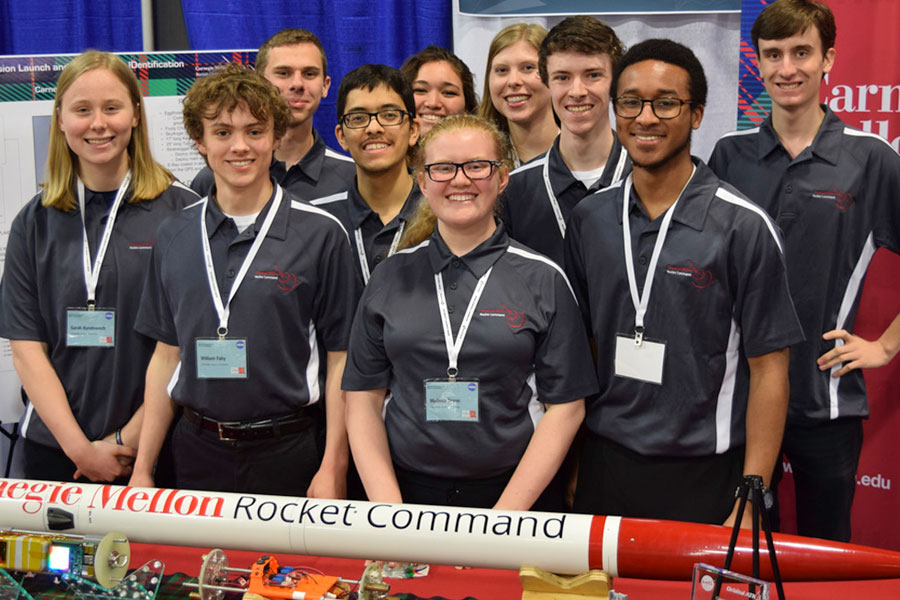
Flying High: Carnegie Mellon Rocket Command Soars in NASA Competition
Including first-year chemistry major William Fahy
By Emily Payne
Media InquiriesCarnegie Mellon Rocket Command (CMRC) soared high in NASA’s Student Launch Competition. The team came away from its first collegiate competition with a top 10 finish and NASA's Altitude Award for coming closest to the one-mile target launch altitude.
The Carnegie Mellon University organization began as a model rocketry hobby club for students.
“At the beginning of this year, we decided our club was ready for the next step, which was to be part of a team competition where we all build one rocket,” said Fabian Aristizabal, a junior double major in physics and mechanical engineering.
They certainly aimed high. The team was one of 45 colleges and universities across the United States accepted to compete in NASA’s Student Launch competition, which received a record number of applications this year. The competition challenges participants to design, build, test and fly a high-powered, reusable rocket while carrying a payload. NASA sets the bar high, pushing students to meet similar challenges and requirements to that of their own aerospace engineers.
From September to April, the teams went through a series of real-world comprehensive flight reviews overseen by NASA staff, engineers and scientists, culminating in the final launch near NASA’s Marshall Space Flight Center in Huntsville, Alabama. In addition to completing two test launches, the team had to submit reports, sometimes nearing 200 pages, and present their progress via video conference at several points along the way.
The venture took a lot of heart and soul, and with virtually no budget, a lot of fundraising. Guided by CMRC president and team leader Genevieve Parker, the team solicited support from their departments in computer science, physics, chemistry and engineering, applied for funding from Student Affairs and raised more than $5,000 through CMU Crowdfunding to help make their rocket come to fruition.
NASA’s competition tests students’ ability to launch their rocket one-mile into the air while completing one of three payload challenges. CMRC chose to tackle the target detection challenge, which included building an onboard camera system that could identify targets on the ground. The CMRC team relied on the talents of students from physics, mechanical engineering, materials science & engineering, electrical & computer engineering, computer science, chemical engineering and chemistry to build their rocket.
Aristizabal served as flight calculations and analysis lead, overseeing the parachute selection team and managing work on fin analysis and air frame design.
“One of biggest challenges was we didn't have access to a lot of tools that a university with an aerodynamics department would have, tools like wind tunnels to simulate drag,” Aristizabal said. “To get over that challenge, we had to use our coding skills to be able to simulate the action of rocket parts without the means to physically test it.”
Stepping up to the challenge, William Fahy, a first-year chemistry major, wrote a custom program to calculate drift and simulate the rocket’s descent once the parachute is deployed. Aristizabal wrote the other half of the program to simulate the rocket’s ascent.
Fahy also worked closely with Sarah Kurelowech, a first-year physics major, on parachute selection.
“NASA had requirements for how much kinetic energy you could land with and how far the rocket could drift, so we had to pick a parachute that would optimize how far away the rocket drifted and make sure it still hit that kinetic energy level,” Kurelowech said, which is where Fahy’s program came in handy.
They also had to take into account how much force the parachute feels. “When the parachute deploys, it feels more force than what the motor exerts on the rocket. We had to make sure the chords of the parachute wouldn't snap off,” she said.
The nearly year-long experience gave the students much more than a winning title.
“This project was a decision maker for me,” said Kurelowech. “It definitely set in stone that I want to do something hands on in applied physics and aerospace engineering.”
For Aristizabal, the most exciting part was dealing with the inaccuracies of real-time rocket launching. “You're not dealing with ideal situations,” said Aristizabal. “On launch days, we had to use a plastic bag to figure out the general direction of the wind and the local weather station to figure out the local wind speed so we could calculate how to reach the right altitude.”
Going into Student Launch, the group’s overarching goal was to learn the ropes and gain experience in the world of competitive rocket building. Riding on the success of their first competition, CMRC is already gearing up for next year. They can only go up from here.
Originally published: https://www.cmu.edu/mcs/news-events/2018/0511_NASA_SL.html